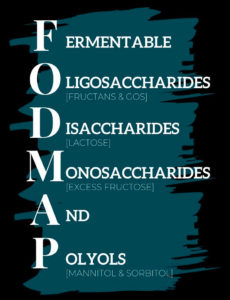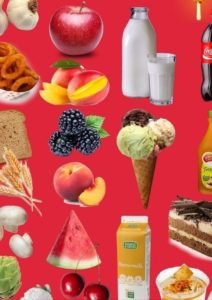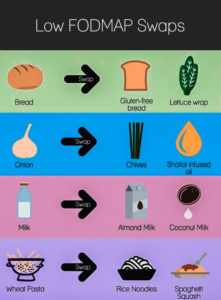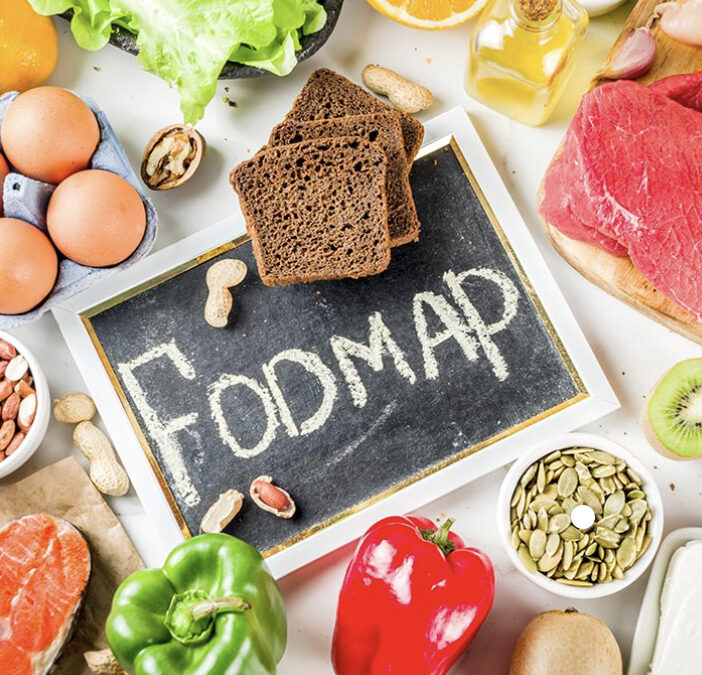
WHAT ARE FODMAPs?
The acronym FODMAP stands for Fermentable Oligosaccharides, Disaccharides, Monosaccharides and Polyols.
These are short chain (having fewer than 6 carbon atoms) carbohydrates that are poorly absorbed by the body. They can be found in a wide range of foods such as grains (cereals and bread), fruit, vegetables, legumes, honey, dairy and sweeteners.
A diet high in FODMAPs can result in abdominal pain, bloating, gas, diarrhoea and constipation.
However, as popularity grows online of low-FODMAP diets to help people relieve digestive issues such as Irritable Bowel Syndrome (IBS), a restrictive diet presents other issues.
FODMAP FOODS

Firstly, let’s look into the some of the common dietary sources of the four groups of FODMAPs:
- Oligosaccharides: wheat, brussels sprouts, white part of spring onion rye, onions and shallots, garlic, chicory, black teas, chamomile tea, fennel tea, chai tea, barley, beer, white part of leeks, watermelon, legumes such as kidney beans and haricot beans, baked beans, cashew nuts, lentils, pistachios and nectarines.
- Disaccharides: yoghurt, soft cheeses, milk, custard, dairy-based deserts, whey protein and ice cream.
- Monosaccharides: apples, sun dried tomatoes, figs, dried fruit, fruit juices, coconut water, rum, sports drinks, asparagus, cherries, honey, mangoes, pear and sugar snap peas.
- Polyols: sweeteners, plums, lychee, blackberries, cauliflower, apricots and mushrooms.
FODMAP FOODS INFLUENCE ON THE BODY
FODMAPs are poorly absorbed by the small intestine. It is osmotically active which leads to secretion of fluid into the small intestine. This increases water delivered to the colon which can lead to diarrhoea experienced by some people.
The FODMAP group are rapidly fermented by the colonic microbiota, leading to bloating, gut pain and gas.
Measuring breath hydrogen production levels is an indication of how much gas is produced by the microbiota. A low FODMAP diet shows lower breath hydrogen levels suggesting reduced fermentation and gas production by restricting poorly absorbed carbohydrates.
LOW-FODMAP DIET

Research has proven that the introduction of a low-FODMAP diet can help people suffering from IBS and relieve symptoms – “Efficacy of the low FODMAP diet for treating irritable bowel syndrome: the evidence to date”
However, there does remain controversy as to whether a low-FODMAP diet will benefit everyone suffering from IBS.
The National Institute for Health and Care Excellence (NICE) has published it’s own traditional dietary guidelines for IBS in adults. These included style of eating and food choice whilst allowing some FODMAP foods.
The NICE compared its own approach to management of IBS with a low-FODMAP approach. The low-FODMAP approach response resulted in a superior outcome for the IBS patients.
It must be clear that unless you have IBS, you could be doing more harm to your health by following a low-FODMAP diet.
Most FODMAPs are prebiotics which support the growth of your gut bacteria providing a healthy gut microbiome.
SOME LOW-FODMAP FOODS
- Alfalfa
- Almond butter
- Almond milk
- Almonds (15 max)
- Apple cider vinegar
- Balsamic vinegar (2 tbsp)
- Bamboo shoots
- Bananas (unripe)
- Basmati rice
- Bean sprouts
- Beetroot, canned and pickled
- Beef
- Black beans – 45g
- Black tea (weak)
- Blueberries
- Bok choy / pak choi
- Brazil nuts
- Broccoli
- Brown rice
- Brussels sprouts (2 only)
- Buckwheat
- Bulger (1/4 cup)
- Butter
- Butternut squash (1/4 cup)
- Cabbage (1 cup)
- Cacao powder
- Cantaloupe melon
- Capers (vinegar, salted)
- Carrots
- Celery
- Cheese (Brie, Cheddar, Cattage 2 tbsp, Feta, Goat, Monterey Jack, Mozzarella, Parmesan, Ricotta 2tbsp, Swiss)
- Chestnuts
- Chia seeds
- Chicory leaves
- Chick Peas (1/4 cup)
- Chicken
- Chilli
- Clementine
- Cocoa powder
- Coconut milk, cream, flesh
- Coconut yoghurt
- Cod
- Coffee
- Corn (small amounts)
- Corn bread
- Corn flour
- Courgette
- Crab
- Cucumber
- Dark chocolate
- Dijon mustard
- Dragon fruit
- Eggplant / aubergine
- Eggs
- Fennel
- Flax seeds
- Fruit tea (weak) – no apple added
- Galia melon
- Ghee
- Gin – (limited intake advised) – gut irritant in excess
- Ginger
- Gluten-free breads
- Gluten-free pastas
- Goats yoghurt
- Golden syrup
- Grapes
- Greek yoghurt (small amounts)
- Green beans
- Green pepper
- Green tea
- Guava (ripe)
- Haddock
- Hazelnuts
- Hemp milk
- Hemp seeds
- Herbal tea (weak)
- Honeydew melon
- Jam (strawberry)
- Kale
- Ketchup
- Kiwi fruit
- Lactose free milk
- Lactose free yoghurt
- Lamb
- Lard
- Leek leaves
- Lemon
- Lentils (small amounts)
- Lettuce
- Lime
- Lobster
- Macadamia milk
- Macadamia nuts
- Maize starch
- Mandarin
- Maple syrup
- Marmalade
- Marmite
- Mayonnaise
- Miso paste
- Milk chocolate (3 squares)
- Millet
- Mixed nuts
- Mussels
- Mustard
- Oat bread
- Oatmeal (1/2 cup)
- Oat milk
- Oats
- Oatcakes
- Olives
- Orange
- Oysters
- Oyster sauce
- Papaya
- Parsnip
- Passion fruit
- Peanuts
- Peanut butter
- Pecans (15 max)
- Peppermint tea
- Pesto sauce
- Pickled gherkins
- Pickled onions
- Pineapple
- Pine nuts (15 max)
- Plaice
- Polenta
- Popcorn
- Poppy seeds
- Pork
- Porridge
- Potato
- Potato flour
- Potato flour-bread
- Potato starch
- Protein powders – Egg, Pea (20g), Rice, Whey protein isolate
- Prosciutto
- Pumpkin
- Pumpkin seeds
- Quinoa
- Quorn
- Radish
- Raspberry
- Red pepper
- Rice bran
- Rice bread
- Rice cakes
- Rice crackers
- Rice flakes
- Rice flour
- Rice milk
- Rice noodles
- Rice wine vinegar
- Rhubarb
- Salmon
- Seaweed
- Sesame seeds
- Shrimp
- Sorbet
- Soy protein
- Soy sauce
- Spelt sourdough bread
- Spinach
- Squash
- Stevia
- Strawberry
- Sugar
- Sun-Dried tomatoes (4 tomatoes)
- Sunflower seeds
- Swede
- Sweet potato
- Tapioca starch
- Tofu
- Tomato
- Trout
- Tuna
- Turkey
- Turnip
- Vegemite
- Vodka (limited intake advised) – gut irritant in excess
- Walnuts
- Wasabi
- Water
- Water chestnuts
- Wheat-free breads
- Wheat-free pastas
- Whiskey – (limited intake advised) – gut irritant in excess
- White rice
- White tea
- Wine – (one glass)
- Worcestershire sauce
- Zucchini
STARTING A LOW-FODMAP DIET – ELIMINATION

Initially, avoid all high-FODMAP foods. This stage should only last 1-2 months. You need FODMAPs in the diet for a healthy gut and long-term avoidance will create health issues.
Once you start to notice improvements, systematically reintroduce FODMAP foods. This will allow you to identify the types of food that you can tolerate and those that trigger IBS symptoms.
Introduce specific foods one at a time for 3 days (avoid all sugar-free foods that include mannitol and sorbitol and other “ol” sweeteners).
Finally, you will have list of foods that you can tolerate and will be able to identify those that are not suitable for you.
However, it is essential that you do not follow a low-FODMAP diet for more than 2 months.
Before going on any restricted diet, you should consult your health professional with expertise in dietary management.

